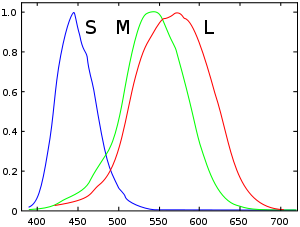
LMS Color Space
Encyclopedia

Color space
A color model is an abstract mathematical model describing the way colors can be represented as tuples of numbers, typically as three or four values or color components...
represented by the response of the three types of cones
Cone cell
Cone cells, or cones, are photoreceptor cells in the retina of the eye that are responsible for color vision; they function best in relatively bright light, as opposed to rod cells that work better in dim light. If the retina is exposed to an intense visual stimulus, a negative afterimage will be...
of the human eye
Human eye
The human eye is an organ which reacts to light for several purposes. As a conscious sense organ, the eye allows vision. Rod and cone cells in the retina allow conscious light perception and vision including color differentiation and the perception of depth...
, named after their responsivity
Responsivity
Responsivity measures the input–output gain of a detector system. For a system that responds linearly to its input, there is a unique responsivity. For nonlinear systems, the responsivity is the local slope ....
(sensitivity) at long, medium and short wavelengths.
It is common to use the LMS color space when performing chromatic adaptation
Chromatic adaptation
Chromatic adaptation is one aspect of vision that may fool someone into observing a color-based optical illusion, such as the same color illusion.An object may be viewed under various conditions. For example, it may be illuminated by sunlight, the light of a fire, or a harsh electric light...
(estimating the appearance of a sample under a different illuminant).
XYZ to LMS
Typically, the color to be adapted will be specified in a color space other than LMS, but easily convertible to XYZ. The chromatic adaptation matrix in the von Kries transform method, however, is diagonal in LMS space, thus the usefulness of a transformation matrix M between spaces. The transformation matrices for some chromatic adaptation models in terms of CIEXYZCIE 1931 color space
In the study of color perception, one of the first mathematically defined color spaces is the CIE 1931 XYZ color space, created by the International Commission on Illumination in 1931....
coordinates are presented here.
Notes :
- All tristimulus values are normally calculated using the CIE 1931 2° standard colorimetric observer..
- Unless specified otherwise, M is normalized (the rows add up to unity) so the tristimulus values for an equal-energy illuminant (X=Y=Z), like CIE Illuminant EStandard illuminantA standard illuminant is a theoretical source of visible light with a profile which is published. Standard illuminants provide a basis for comparing images or colors recorded under different lighting.-CIE illuminants:...
, produce equal LMS values.
CMCCAT97
The CMCCAT97 color appearance model uses the Bradford transformation matrix (MB):
RLAB
The RLABRlab
Rlab is an interactive, interpreted numerical computation program and its core programming language, written by Ian Searle. Rlab is very high level and is intended to provide fast prototyping and program development, as well as easy data-visualization, and processing.Rlab was not designed as a...
color appearance model uses the Hunt-Pointer-Estevez (HPE) transformation matrix (MH) for conversion from CIE XYZ
CIE 1931 color space
In the study of color perception, one of the first mathematically defined color spaces is the CIE 1931 XYZ color space, created by the International Commission on Illumination in 1931....
to LMS:
| Equal-energy illuminants: |  |
| Normalized to D65: |  |
CAT97s
CIECAM97s uses a spectrally-sharpened Bradford chromatic adaptation matrix:
CAT02
The chromatic adaptation matrix (MCAT02) from the CIECAM02CIECAM02
Published in 2002 by the CIE Technical Committee 8-01 , as of 2008 CIECAM02 is the most recent color appearance model ratified by the CIE, and the successor of CIECAM97s.| quote=The CIECAM97s model was adopted by the CIE in 1997 for color imaging applications. It includes forward and reverse modes...
model is:


